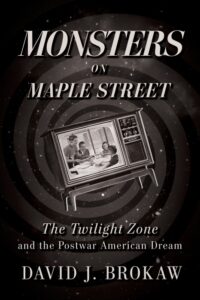Monsters on Maple Street: The Twilight Zone and the Postwar American Dream by author and historian David J. Brokaw delivers a thought-provoking examination of the relationship between the classic science-fiction show The Twilight Zone and post-World War II America.
Reading this non-fiction book is like taking a step back into the 1950s and 1960s, to a time when sponsors heavily censored television shows, ensuring a white-washed American dream on every television set. Monsters on Maple Street takes a deep dive into the social commentary not so subtly lurking in crucial episodes of The Twilight Zone. Brokaw explains that The Twilight Zone criticizes the American dream by introducing viewers to the American nightmare through a lens of sci-fi and horror, allowing The Twilight Zone to escape censorship due to it being a fictional show.
Brokaw connects the dots between episodes of the show to disturbing themes like racism, war, propaganda, white supremacy, and consumerism in a way that’s cleverly explained and thoroughly researched.
The layout of the book also helps strengthen Brokaw’s points, with each chapter delving into a different theme from post-World War II America with Twilight Zone episodes to match.
Pictures from The Twilight Zone are also in every chapter, allowing readers to connect to the brief synopses of each episode even further. In addition to pictures, each synopsis’ length is perfect, with every description summarizing the plot nicely while remaining interesting and engaging.
The descriptive language used throughout this book means that readers don’t have to be history buffs or experts on every Twilight Zone episode to understand and enjoy its contents. However, a reader who has little interest in history or The Twilight Zone may have trouble becoming fully invested as it does sometimes read like a history or communications textbook. Monsters on Maple Street is an in-depth peek into American history, but with little modern relevancy, it can be hard to stick with.
The introduction of the book also ran a little too long at nearly 25 pages, and was often quite repetitive, which to a certain extent is forgivable, but it felt like the reader was being spoon-fed the same information instead of being able to draw conclusions naturally. Once the introduction was finished, it became much more enjoyable because the remainder of the book isn’t as exhaustingly over-explained.
Overall, this is a book rich in history that showcases the horrors hiding behind the American dream. Each chapter offers a different perspective on the many issues that plagued America in the mid-1900s through Twilight Zone episodes. The combination of history and science fiction makes for a one-of-a-kind read that leaves readers with a better understanding of The Twilight Zone and its social commentary.

